What’s the difference between Nissan’s 370Z and the new just-Z?
A smaller engine – and a lot more horsepower. Also about 200 more pounds.
But that hasn’t slowed things down.
What It Is
The Z – as it’s now called – is the descendant of Datsun’s (as Nissan was once called) 240Z sports car, which made its debut in the United States back in 1969. It is similar to the original in general layout: Two seats, a hatchback rear (which makes this small sports car much more practical than sports cars with just a tiny trunk), rear wheel-drive, six cylinder engine and manual transmission.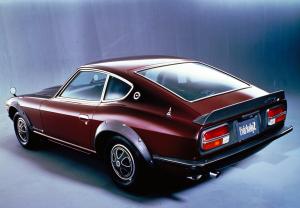
It differs from the original in that the new Z’s six is a V6 – rather than the original’s in-line six – and the V6 has two turbos and makes about three times as much power. The new Z is also a much quicker Z – being capable of getting you to 60 in just over 4 seconds.
A ’69 240Z took about 8 seconds to get there, right on pace with a new Corolla.
But – like the original Z – the new one is an elemental one with minimal distractions from the drive. This includes the standard manual transmission – in every trim – which keeps your attention focused on the drive.
It even has a pull-up emergency brake – a thing as rare to find in a new car (even a sports car) as an ash tray and for the same politically incorrect reasons.
Prices start at $39,990 for the base Sport trim. The next-up Performance trim – $49,990 – adds a more aggressive 19-inch wheel/tire package, more aggressive suspension tuning, a limited slip differential, upgraded brakes and electronically-assisted rev-matching shifts for the six speed manual transmission.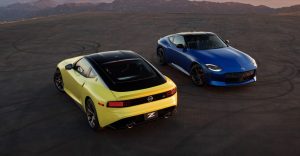
You can opt for a nine speed automatic if you prefer.
The range-topping Proto Spec – $52,990 – has all of additional hardware that comes with the Performance plus a set of lightweight Rays wheels and a unique yellow and black paint/trim scheme.
What’s New for 2023
The Z is all-new.
Manual transmission isn’t restricted to just one trim.
All trims come standard with the same 400 horsepower engine.
Hatchback layout makes this sports car more practical than others, such as the Subaru BRZ/Toyota GR86 and Mazda Miata.
What’s Not So Good
V6 isn’t as smooth – or as revvy – as Toyota Supra’s inline six.
Startlingly heavy (3,486 lbs.).
Big price increase vs, last-generation 370-Z, which stickered for about $7k less to start.
When Datsun – today’s Nissan – introduced the 240Z back in ’69, it was powered by a 2.4 liter single overhead cam inline six with a pair of side-draft carbs that made 151 horsepower. This was enough power to be sporty enough in a car that weighed just 2,260 lbs. The original Z wasn’t very quick by modern sports car standards but it was very fun – and that’s why the car was a big hit and became one of the most popular cars of the ’70s and into the ’80s.
The new Z has almost three times the power – because it’s nearly a third again as heavy – and so needs it.
It weighs more than several current mid-sized sedans, including the Honda Accord (3,230 lbs.) even though it is a compact-sized sports car – and some 1,226 pounds more than the first 240Z. Much of the reason for this has to do with the fact that today, sports cars are obliged to comply with impact standards that didn’t exist 50 years ago and are equipped with things like seats with air bags built into them that didn’t exist back then, either.
All of which adds weight.
Even so, the new Z is a beefy car.
To put a finer point on this, consider that the ’23 Miata – which is both a small sports car like the Z and a roadster (convertibles generally weigh more than hardtops because of the additional body bracing needed to make up for the lack of a metal roof) manages to weigh in at just 2,341 lbs., or just slightly heavier than a ’69 240Z hardtop.
Anyhow, to make up for the weight that would otherwise slow it down, the new Z has a 3.0 liter V6 – the same engine used in the Infiniti Q60 Red – that’s a third again as large as the 2.4 liter inline six that powered the original 240Z – and it makes 400 horsepower, nearly three times as much power as the original 240Z’s 151 horsepower.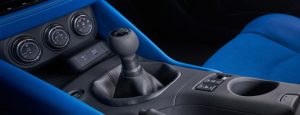
It has two turbos to make all that power. The last-generation 370Z’s V6 had none.
This is how a nearly 3,500 lbs. sports car gets to 60 in just over 4 seconds – which is much quicker than a Miata as well as the Subaru BRZ/Toyota GR86 twins. Toyota’s Supra – which is available with a 382 horsepower 3.0 liter in-line six – is quicker than the Nissan because it’s substantially lighter (3,181 lbs.) but it is also substantially more expensive: $44,040 to start – without the six. That’s with the standard 2.0 liter, 255 horsepower four – which also comes standard (and only) with an automatic transmission. If you want the optional six – and the available manual transmission – the Toyota’s base price rises to $53,000. That’s a $12k difference in price and it makes up for a couple of tenths, 0-60.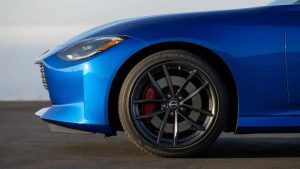
Another laudable thing about the Z is that it comes standard with the manual (as a sports car should) and in every trim. An automatic is available but you don’t have to pay for it if you don’t want it. Far more important, you don’t have to pay extra to get the manual, if you prefer it.
Allegedly, you’ll pay more for gas – in that the EPA says the manual-equipped Z gets 18 city, 24 highway while the automatic-equipped one is rated as being a bit better on gas: 19 city, 28 highway. But the contrast between MPG numbers in such a case – usually in favor of the automatic-equipped version of a car – is based on government testing, not real-world driving. Better mileage numbers – on the test – can be achieved with an automatic that has multiple overdrive gears (as here) that can be programmed to upshift as soon as possible into those overdrive gears. This reduces engine RPM – and that’s how you increase MPGs on those government tests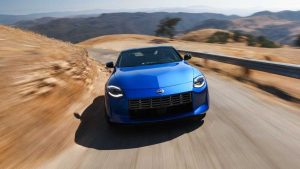
On The Road
The new Z is about 1 second quicker to 60 than the previous 370Z as well as an easier-driving Z.
A pair of turbos will do that.
In the old car – which had an engine that made plenty of power (332 horsepower) but not until 7,000 RPM – and which didn’t have a lot of torque (just 270 ft.-lbs.) and not until 5.200 RPM – it was necessary to rev the engine to get the wanted reaction. This isn’t a bad thing in a sports car – unless you’re commuting in it. On the track – or on an open back road – the old 370 was what it was supposed to be and behaved like it.
The new car behaves differently – when you haven’t got the room to let the engine wind out. You no longer need to, because of all the torque the new turbocharged engine develops – all 350 ft.-lbs. of it at all of just 1,500 RPM. You can drive the Z like a Corolla, if you like. Just a little pedal pressure delivers more than enough power to put-put from red light to red light and it’s not necessary to shift much as you do.
But when the light goes green, it goes.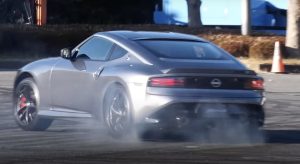
The chief complaint here is the sound. It isn’t bad – but it’s not as good as the sound made by an inline six, as in the Supra. This is just the nature of things in that V6 engines almost never sound as good as inline engines and they’re generally not as revvy, either – because they need heavier balancing of their reciprocating assembly to maintain smoothness.
Inline sixes are naturally smooth.
So why doesn’t the Z have one – as the original Z cars did? Probably because Nissan hasn’t got one – and neither does Toyota. The Supra’s optional inline six is a BMW six. The reason neither of these two huge car companies have inline sixes of their own is because it’s too capital-intensive to design a new engine – and secure government approval for it – and make money on it, selling it in relatively low numbers in a low-volume specialty car such as the Z or the Supra.
That’s why Toyota buys the Supra’s six from BMW – and Nissan uses an already-in-use 3.0 V6 borrowed from an Infiniti in the Z.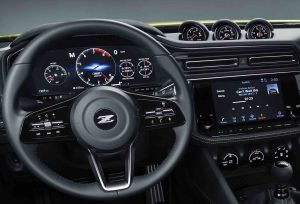
At The Curb
The new Z looks a lot like the previous 370Z in general terms. Same basic swoopy shoe shape but a little longer overall (172.4 inches now vs. 167.5 then).
Interior dimensions are almost exactly the same – including the same 42.9 inches of legroom and 38.2 inches of headroom and 54.2 inches of shoulder room. It’s a cozy space for two.
Nissan has incorporated some some interior design touches that hearken back to the original Z of the early ’70s, including original Z badges on the C panels outside and the steering wheel horn button inside. You’ll also find a top-of-dash mounted triple accessory gauge cluster, which is also traditionally analog.
The main gauge cluster is now a flatscreen, though – dominated by a large tachometer in the center with smaller gauges off to the right. There is another LCD screen in the center stack for the audio system controls but there are also still manual/knob controls for the AC/heater/fan, which makes them much easier to use in between gear-changes, while you’re actually driving this car. 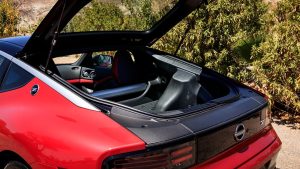
One thing that’s carried over – all the way from 1969 – is the new Z’s hatchback rear, which gives the new Z a big practicality advantage over sports cars with trunks that have almost no room for carrying anything except you and one passenger.
It’s no so much that the well is deep but rather that you’ve got more length – and a much wider opening – to work with. In extremis, it is possible to use the Z to transport home a chest freezer (don’t ask, I won’t tell) which isn’t something you can easily do with sports cars that have trunks.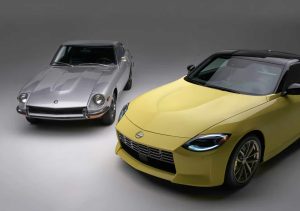
The base Sport trim has all the necessaries – except for one of them.
A critical piece of equipment that’s missing is a limited slip axle, which you have to buy the $10k more expensive Performance trim to get. This would not be so bad were it not for the fact that a limited slip axle is an essential in a rear-drive sports car with this much power. Without it, the Z’s right rear tire goes up in smoke when you try to take maximum advantage of all 400 horses.
This vital piece of equipment ought to be at least an al la carte option.
The new Z is considerably more expensive than the previous 370Z – but it’s also a lot less expensive than the rival it’s most closely similar to, Toyota’s Supra. Even more so when you take into account that the Supra doesn’t come standard with a six while the Z does.
It is also not that much more expensive – in base trim – than a loaded Subaru BRZ or Toyota 86 – and neither of the latter offer anywhere near as much power (just 228 horsepower) and they both have trunks.
The Bottom Line
One often hears the phrase, for the money it’s a pretty good deal. That cheapens a pretty sweet deal, which is what Nissan’s offering here.
. . .
If you like what you’ve found here please consider supporting EPautos.
We depend on you to keep the wheels turning!
Our donate button is here.
If you prefer not to use PayPal, our mailing address is:
EPautos
721 Hummingbird Lane SE
Copper Hill, VA 24079
PS: Get an EPautos magnet or sticker or coaster in return for a $20 or more one-time donation or a $10 or more monthly recurring donation. (Please be sure to tell us you want a magnet or sticker or coaster – and also, provide an address, so we know where to mail the thing!)
My eBook about car buying (new and used) is also available for your favorite price – free! Click here. If that fails, email me at [email protected] and I will send you a copy directly!


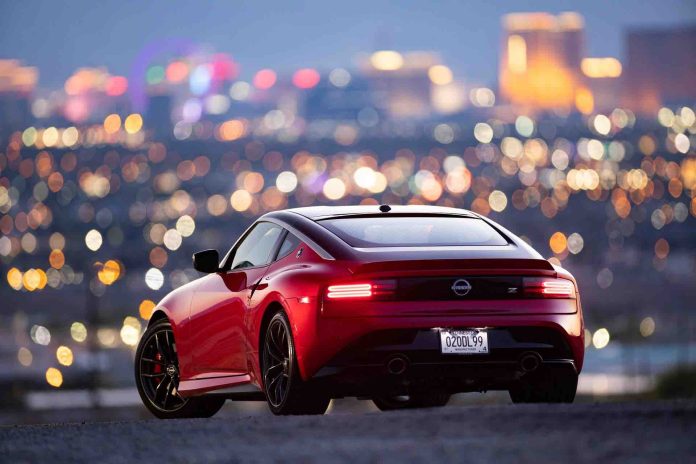



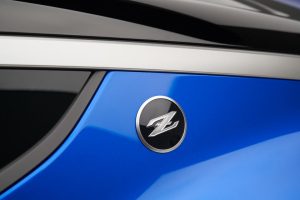








Found this on one of my usual sites:
https://www.pandamotorworks.com/collections/nissan-z
Intercooler/Charge Pipes, Downpipes, KW Coilovers, Lower Manifolds, CF hatches, etc.. It’s not a dedicated site, that would be this: https://www.z1motorsports.com/?m=NEWZ, but it’s good to see there’s already fixes and upgrades to address some of the deficits
“The reason neither of these two huge car companies have inline sixes of their own is because it’s too capital-intensive to design a new engine – and secure government approval for it – and make money on it, selling it in relatively low numbers in a low-volume specialty car such as the Z or the Supra.”
Somehow Mazda has been able to create a new inline six for its new CX90. Jeep also has a new inline six for its Wagoneer models. Hopefully both companies will be able to use them on some sportier models in the future.
Hi Robbie,
Yes, but those Mazda and Jeep models will (are expected to) sell in numbers far larger than the number of Z cars (and Supras) sold by Nissan and Toyota, etc.
I had a couple of Z’s back in the day. My 240 had the driving feel of a Japanese Corvette without the raw power. A totally fun car to drive and with a seat track that a 7 foot driver could get into. Aside from the temperamental carbs and weak cooling system it was trouble free. The 260 and 280s should have been better cars, but the EPA killed that with cumbersome and complicated emissions systems. The 300 was a comfortable boat, but in no way a true sports car.
If I were to build a sleeper road car for my old frame today (short of a CTS-V) a $30,000 V6 Carmy with some sly suspension work would lose 100 HP but keep the bears from smelling you coming.
Which 300, the 80s or 90s one?
I hear people daily 900whp 90s twin turbo’s, plus with modern parts, you can fix the issues the had in the past
Thanks Eric, my daughter is looking for a sports car, and she was all-in on bmw, audi, etc… but she would have to buy used to afford them. Then I saw the Toyota GR86 and pointed one out to her, and she liked it, and the price. And we will now add this car to the list. Forgot about it.
Much better for a young adult to get one of these vs the EU brands. Hopefully she agrees.
I love the Toyobaru, briefly test drove it when it was a scion and still fondly remember it to this day
Hell, might get one myself. Theyre Miata’s with backseats for storage and the newest old car you can get (i.e. 90s analogy old, not literally), and best bang for your buck.
I hope so too Chris, she wont regret it, just get a manual for extra fun as well
Amen, Zane –
Also, for those who prefer a hardtop, this one’s the ticket. The boxer engine can also be hotted-up with any of a plethora of available aftermarket upgrades. It’s not as agile as the Miata, but it does have a lot going for it.
Id get a Miata, but I gotta soft top on my Bronco already.
Id trade the rag top and some weight for a backseat for my stuff or my niece and nephew to sit.
Also, they did mostly mitigate that torque dip, although Id do unequal length headers and avoid a catback to not get drone
Eric, I’m confused I thought the GR86 had a inline 4-NA like the Miata? And the Z had a V6TT?
Boxer? If so, not my fav. but she wouldn’t know the difference.
even the internet is confused:
https://www.google.com/search?q=toyota+gr86+engine&oq=toyota+gr86+engine&aqs=chrome..69i57j0i512l6j69i60.9384j0j4&sourceid=chrome&ie=UTF-8
Hi Chris,
The 86 shares its drivetrain with the Subaru BRZ; both have the same Subaru-made drivetrains – including the boxer four. The Z has the 3.0 V6.
ahhhh, thanks Eric. So the Miata shares with ?
Hi Chris,
The Miata briefly shared its chassis with the Fiata… the 124 Spider. Which had a Fiat-Alfa turbocharged engine!
Hey Eric, thought you drove a current gen toyobaru, do you have any scheduled this year?
Love to see what you think of it compared to the previous gen
Thanks Zane, I thought it resembled the Miata, but didn’t remember. Now that I look, the GR86 has a more forward seating position, to allow for the tiny rear ‘seats’, which is always better to have than not. She is living in a southern climate so I think RWD won’t be an issue. If she wants to go skiing or over the mountain passes in the winter, she’ll just have to go with someone else or rent a car.
Looks like a winner.
Or slap on snow tires, like they did with Everyday Driver in the previous gen
not sure she has the skills, but I will check out the E-D episode. Thanks.
https://m.youtube.com/watch?v=JKBdOE2z4O4
Welcome
thanks Zane. I know I can do it, and have with many RWD only cars, last one being a 300S, and while I suffered with all-seasons, I never got stuck and even passed many FWD units on hills. Once, I pushed it on purpose, waiting for 6-8 inches on the road and headed home, almost gave up and walked a mile from my house, but persevered and made it. My daughter won’t have the skill set, yet at least, hope she wants to try it.
For me, if it comes to it, Id have my Bronco for it, though it hardly snows anymore in Jerzy.
Had Michelin’s on my old EcoStang, AS3’s I believe, made it up and down my parents hilly driveway with ease when anything not awd would get stuck (i.e up and down hill), so its always tires>drivetrain if ya need one car.
At least shes ahead of the curve compared to her peers
Thanks Zane, and you are correct, she loves cars and fun, meaningful cars. The kind Eric and many here wish will stick around. My son too.
And i never had fancy sport cars raising them, just mostly pickup trucks, but maybe just my passion for car/motorcycle/racing things got them interested. Certainly I always loved and admired cars and engines.
Took them to a real go-cart racing track, not the commercial type, and they were enamored with them. I took them off-weekend, rented a few real racing carts for a day and challenged them to beat the old man. They couldn’t, but maybe the die was cast. She still wants to be a F1 driver, haha….
40K hurts, but I find this car exciting.
It leaves some to be desired, and a 50K fat sports car seems a bit unsporty, it has a 6, not 2.0 4.
It has a shift it yourself lever.
Hell, that alone makes it worth a test drive.
Sorry to call you out Eric, but a 3500 pound “sports car” is an oxymoron. Like calling a bull elephant dainty. The BMW Z4 went the same way decades ago.
You’re right, John…
The horsepower masks the weight – some, in a straight line. But the car feels heavy. A Miata weighs 1,000-plus pounds less… and it’s only a slightly smaller overall.
‘It differs from the original in that the new Z’s six is a V6 – rather than the original’s in-line six.’ — eric
With all the obsession about ‘passion brands,’ you’d think auto makers would stick to the brand formula. The Nissan 240Z, 260Z and 280Z all featured an inline six, with a lo-o-o-ong hood to accommodate it. That’s what defined the Z cars, just as the same straight-six, long hood configuration shaped the iconic Jaguar E-type. Forms follows function.
In that era, most cars had either inline sixes or V8s, with some I-4s in imports. From this retro perspective, a V6 is a crudely amputated V8, with two of its cylinders missing. A practical, space-saving compact powerplant, to be sure, but fundamentally disfigured. Lacking in inherent balance, a V6 has to be kludged with supplemental balancing measures.
Jaguar, BMW, Mercedes-Benz, Aston-Martin, Austin Healey, Maserati, Triumph and Toyota (including the current Supra) all produced classic sports cars powered by inline sixes. Nissan’s expedient selection of a V6 for the new Z car probably dooms it to obscurity — that is, not a collectible like its straight-six predecessors. Whereas the 3.0L Toyota Supra might prove to be.
Amen, Jim –
Of the two, I’d much rather have the Supra. It’s pricier but the BMW six is a gem and really makes the car.
Which do you prefer better Eric, the Supra or the Z?
HI Zane,
Supra. Not even close. The Z is not a bad car. But the Supra is a much more engaging one. The inline six is musical and the car feels more like a Miata than a muscle car. I agree with others who have said the Z ought to have returned to it roots rather than get a reboot; in other words, a longer/lighter car- like the original 240Z – with an inline six rather than a turbo V6.
Imagine that in a sub-3,000 pound package…
‘the ’23 Miata … manages to weigh in at just 2,341 lbs., or just slightly heavier than a ’69 240Z hardtop.’ — eric
From its beginning through the current fourth generation, the MX-5 had a strict weight budget and stuck to it. The Miata is like the svelte girl from high school who still has the same sensational figure at the 30th reunion.
Why do all the others relentlessly pork out? The late Paul Fussell once claimed that thrifty buyers like to get the most pounds per dollar. That might be true for luxury sedans and pickup trucks for contractors. But if you deplore the ponderous feel of weighty vehicles, a 3,486-lb sports car is an oxymoron.